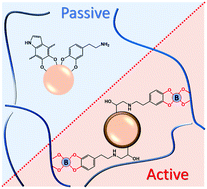Bio-inspired surface modification of iron oxide nanoparticles for active stabilization in hydrogels
Abstract
Biological materials employ a variety of dynamic interactions in sophisticated composite structures to function adaptively on different time and length scales. Inspired by such designs we develop a novel surface modification approach to promote dynamic interactions between nanoparticles and polymer chains in physical and double network hydrogels. Physical hydrogels are formed via reversible complexation of borate ions with poly(vinyl alcohol) (PVA) and chemical crosslinks are introduced by electron beam irradiation. Dopamine is used for surface modification of magnetic iron oxide nanoparticles (MNPs) in two different ways: the direct treatment results in anchoring via catechol groups, whereas the indirect method leaves the catechol group on the free surface of MNPs. Although the former particles show very good colloidal stability, they lower the network connectivity, which results in lower plateau modulus, faster terminal relaxation, and lower yield stress, presumably due to imposing an extra distance between PVA chains. In contrast to this passive design, the latter particles actively reinforce the network by forming clusters of physical bonds between catechol groups of the individual particles and the monodiol complexes of the borate ions and PVA chains. Moreover, the additional complexes formed upon the introduction of nanoparticles with active surfaces provide further energy dissipation potential and therefore enhance the toughness. This approach can help develop novel hydrogels with superior toughness and multiple stimuli-responsiveness.



 Please wait while we load your content...
Please wait while we load your content...